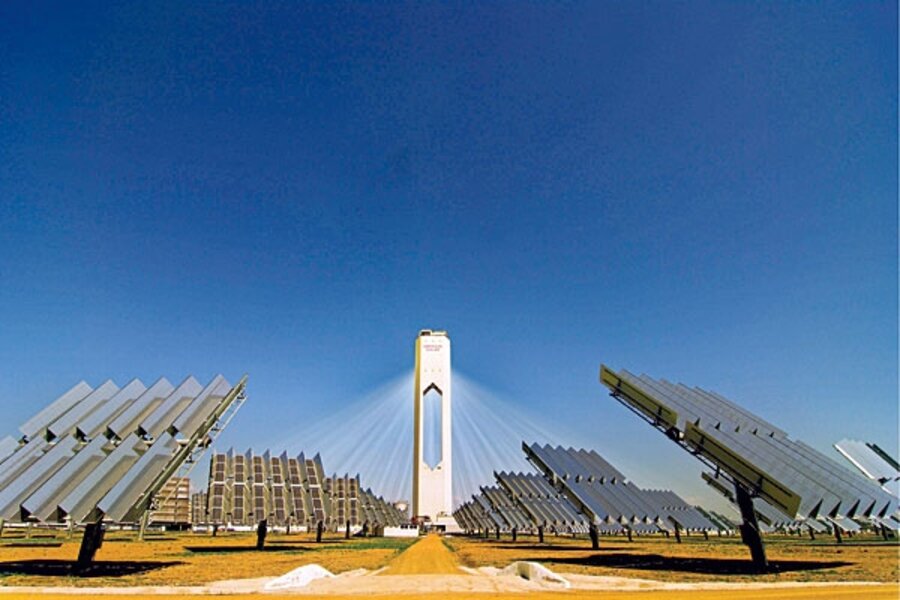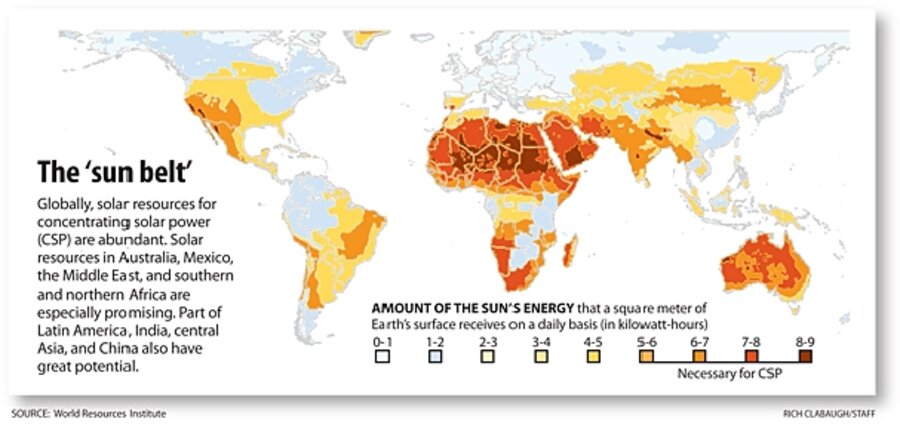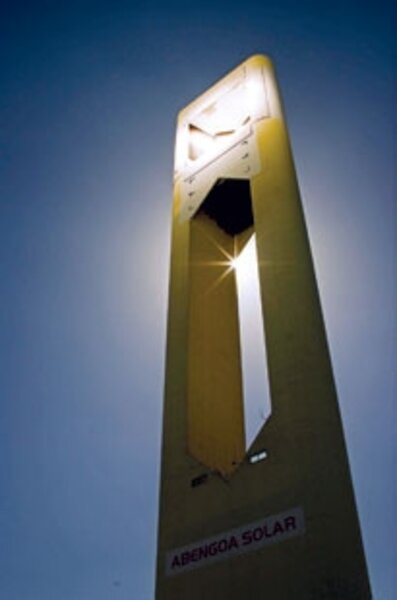Sunrise for solar heat power
Nearly a century ago, American engineer Frank Shuman erected five immense, trough-shaped mirrors in Meadi, Egypt. The parabolic reflectors directed sunlight onto a tube suspended above their 200-foot lengths. Water inside the tubes boiled and created steam. The steam powered a 65-horsepower engine, which pumped 6,000 gallons of water per minute from the Nile River to nearby cotton fields. It was the world’s first concentrated solar power (CSP) plant.
CSP entails focusing the sun’s rays with a reflective surface and putting that energy to work. These days, the heat usually goes to generating electricity. But the principle is quite old.
The ancient Chinese used concave mirrors to start fires, and, according to legend, the Greek mathematician and scientist Archimedes once used mirrors, perhaps of polished bronze, to ignite and burn an invading Roman fleet.
Shuman was addressing a concern of his time: Fossil fuels, particularly coal, powered the Industrial Revolution – the trains and mills, among other things, that radically changed human experience. But what happens when they ran out?
“One thing I feel sure of, and that is that the human race must finally utilize direct sun power or revert to barbarism,” Shuman told Scientific American magazine in 1911.
Fighting during World War I destroyed Shuman’s plant. But in the end it was cheap, abundant oil that obviated his ideas – or seemed to.
The oil crises of the 1970s again piqued interest in CSP, and, in the 1980s, plants resembling Shuman’s began cropping up in the Mojave Desert. Then natural-gas prices plummeted and the cycle repeated itself. No new commercial-scale CSP plants were built for nearly 20 years.
Now CSP is poised for a second – or third, depending on when the count begins – renaissance. And this time, say experts, it’s here to stay. World CSP capacity is forecast to increase nearly 18-fold in the next five years, from its current 588 megawatt potential to around 10.5 gigawatts. (Very roughly, 100 megawatts is enough energy to power 80,000 houses.) More than half of that new CSP capacity will be installed in the United States.
Several factors are driving the CSP boom. Although utility companies have long viewed CSP as an option for generating electricity from the sun, they’ve hesitated to commit to the technology. That’s partly because CSP becomes efficient and cost-effective only at the megawatt (MW) scale.
Photovoltaics, by contrast, can be installed piecemeal on the kilowatt scale – a panel here, another there. And that’s why photovoltaics have so far dominated the solar market.
Now, the specter of carbon regulation has shifted attention back toward CSP. The prospect of large-scale solar plants is again attractive. The “renewable portfolio” standard – which requires increased production of energy from renewable sources – has also encouraged investment in CSP. And the investment tax credit – a potential 30 percent credit on qualifying solar projects – has made investors more willing to risk capital in CSP ventures.
Solar is here to stay, now
“Twenty years ago, everyone thought the solar era was upon us, and then the industry basically went away when oil and gas got cheap,” says Cara Libby, project manager at the Electric Power Research Institute (EPRI) in Palo Alto, Calif. Now, “it certainly appears that solar is here to stay.”
For their part, power companies like CSP for old-fashioned reasons. For one, it uses a technology – steam-driven turbines – that is familiar after decades of use in coal-fired plants.
CSP plants also have thermal inertia. That means that, if a cloud passes overhead, they can continue operating for a time with the heat already gathered, and that’s without storage.
Assuming no rechargeable batteries, photovoltaic fields, by contrast, stop producing electricity when clouds arrive.
Technology for storing heat in molten salts, meanwhile, promises to extend CSP plants’ generating capacity well into the night.
But the bottom line is that natural-gas prices are volatile, an unknown for anyone trying to turn a profit. By comparison, CSP costs – when stretched over the life of a plant – are mostly (80 percent, by one estimate) related to installation. CSP maintenance costs are relatively small, and the sun, its fuel, is free.
“There’s a hedging aspect in building a solar thermal plant,” says Nathaniel Bullard, a solar-sector analyst with New Energy Finance in Washington. “Right now it makes sense to burn gas; it’s really cheap. But you could, in the future, end up losing your shirt on it.”
Inventor Thomas Edison, a contemporary of Shuman’s and the man who gave us the system of steam-generated electricity distributed by wires, told friends late in his life that “I’d put my money on the sun and solar energy. What a source of power!”
Earth has a natural “sun belt,” a swath of relatively empty subtropical deserts including the US Southwest, the Sahara, the Middle East, and much of Australia. By one estimate, installing CSP plants in just 1 percent of the world’s deserts – an area slightly larger than Ireland – could supply all the world’s electricity.
The German Aerospace Center calculates that, assuming high voltage, transmediterranean transmission lines, just 6,023 square miles of CSP in North Africa could keep all of Europe electrified.
In the US, CSP plants in the Southwest could generate 11,000 gigawatts (GWs) of electricity, says Mark Mehos, principal program manager of concentrating solar power at the National Renewable Energy Laboratory (NREL) in Golden, Colo. That’s roughly 10 times all the electrical generating capacity currently in place, including coal, nuclear, solar, and hydroelectric – more than enough for the country’s energy needs.
In other words, there’s plenty of sun. The real challenge is making CSP technology competitive with coal.
Currently, CSP costs about 14 cents per kilowatt-hour (kWh), within striking range of current combined-cycle natural-gas plants, in which a gas turbine generator generates electricity and a steam turbine uses the waste heat to generate more. A combined-cycle natural-gas plant produces electricity for about 12 cents per kWh.
Pulverized coal plants, on the other hand, generate electricity for 6 cents per kWh – less than half CSP’s cost. But, says Mr. Mehos, if you assume that future coal-fired plants will require carbon sequestration, then that cost moves up to about 10 cents per kWh. That means CSP prices still need to drop by nearly one-third to be competitive with future coal plants.
A plethora of CSP companies are racing to innovate and reduce costs. At this point, CSP technology comes in four general “flavors,” each with different perceived strengths and weaknesses.
Parabolic-trough systems focus the sun’s energy onto a tube running their length. Temperatures in the tube can reach 750 degrees F. A medium in the tube – sometimes synthetic oil that transfers its heat to water, sometimes water itself – collects heat to drive turbines. A second troughlike system, called a Compact Linear Fresnel Reflector, uses several mirrors to focus the sun’s rays on a single receiver tube above.
Trough technology benefits from being proven. That was Shuman’s design, and it’s the one the Mojave plants installed in the 1980s and ’90s. A planned 280-MW CSP plant near Phoenix will use trough technology, and store heat for electrical generation in molten salts.
‘Power towers’ more efficient
But experts say that, although it’s a known quantity, trough technology may be less efficient than newer, albeit less-tested, approaches. One reason: Newer systems achieve higher temperatures, which greatly increase efficiency.
So-called “power towers” – thousands of mirrors, or heliostats, directing the sun’s rays at a central tower – can achieve 1,300 degrees F. They also benefit from not having to pump the receiver fluid through tubing, an energy loss.
The first commercial scale “power tower” plant began operating near Seville, Spain, in 2007. The 11-MW plant resembles a gigantic, silver-petaled flower reflecting rays of light toward a central stamen. (Others compare it to the lidless Eye of Sauron in the “Lord of the Rings” movies.)
In the US, eSolar recently brought a 5-MW “power tower” demonstration plant on line near Lancaster, Calif. It includes a number of innovations, says Jim Shandalov, eSolar’s vice president of business development. Its relatively small mirrors – thousands of them about a yard square – rise no higher than four feet. Compared with troughs, which can be up to 10 feet high, or the Spanish plant, which has mirrors mounted on frames more than 120 square meters in area, the four-foot height keeps the wind profile down. A smaller profile also means fewer building materials.
Small, flat mirrors are also cheaper to manufacture, transport, and install, he says. An automated robot on a track can clean and maintain the mirrors, further cutting costs.
Finally, new software calibrates each mirror individually, an improvement over the “two walkie-talkie men” method of yore, says Mr. Shandalov, “We’ve made it more efficient.” (He won’t say by how much – that’s a trade secret.)
A fourth CSP option uses a reflective parabolic dish. A Stirling engine, the basic design of which is 200 years old, sits at the dish’s focal point. About the size of a motorcycle engine, it contains hydrogen gas. When heated, the gas drives four pistons, generating electricity on the spot. Stirling Energy Systems and its partner company, Tessera Solar, use this approach in their SunCatcher. A 1.5-MW demonstration plant is slated to begin operating in January near Phoenix.
Most efficient method costs more
Some point out that this method’s large pedestals holding the glass parabolas, some 38 feet across, represent a cost that low-profile, flat-mirror approaches have successfully eliminated.
Nonetheless, in purely thermodynamic terms, the SunCatcher is the most efficient CSP approach so far. It converts 31 percent of the sun’s energy to grid-ready electricity. By comparison, photovoltaic ranges between 8 and 15 percent efficiency, and trough CSP between 15 and 19 percent.
The SunCatcher has one more advantage: The engines aren’t cooled with water. The hydrogen cools in an air radiator similar to that found in a car.
That’s important because, in the arid and semiarid regions of the desert Southwest, where CSP makes the most sense, water is already a hot-button issue. And it’s predicted to become more so.
“The Southwest is a great place to build solar, but it’s not a great place to build water-intensive solar,” says Peter Gleick, president of the Pacific Institute in Oakland, Calif., a nonprofit devoted to sustainability issues.
Air-cooling CSP is possible, but can decrease efficiency and – in some situations and regions – increase costs by 5 to 10 percent. Yet for some, it’s already a selling point. BrightSource Energy, a company developing a 400-MW “power tower” plant in the Mojave, touts the fact that its plant will be entirely air-cooled.
Other companies are developing new, cost-saving materials. SkyFuel in Albuquerque, N.M., is testing a reflective laminate material that, it says, is more durable than standard glass. Theoretically usable in any of the CSP approaches, it’s 10 to 20 percent cheaper than glass mirrors, says Andi Plocek, SkyFuel’s marketing director.
Many see cost-effective heat storage as the biggest long-term hurdle for CSP. “The cost of storage is higher than we thought,” says Mehos.
Eventually, utilities will want to generate electricity from renewable sources through the night. To do that with CSP, they’ll need to store the sun’s energy.
Molten salts – used as fertilizer in agriculture – are one solution. But they’re also potentially difficult to handle. They freeze below a certain temperature, possibly clogging the system if allowed to cool. Another consideration with any storage is that with each transfer of heat between media, energy is lost and efficiency diminishes.
In other words, on the cusp of a CSP boom, which technology will dominate and how it will store heat is still very much an open question.
“It’s hard to predict who’s going to win in the end, if there is a winner,” says EPRI’s Ms. Libby: “We need to get more hardware on the ground and really test out all the options.”







